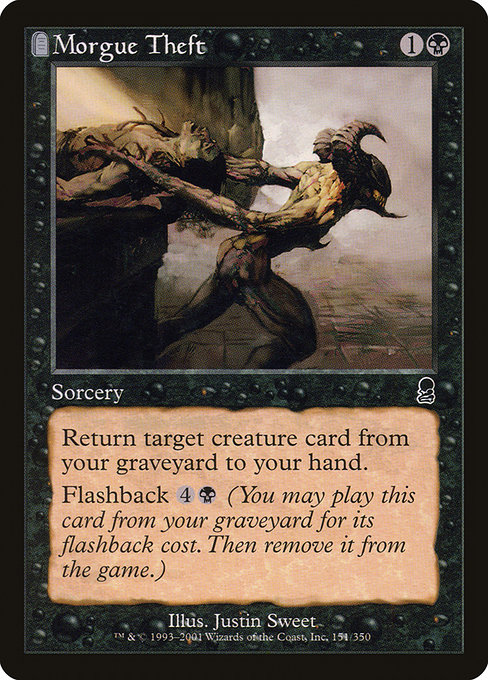
Image courtesy of Scryfall.com
Morgue Theft: How a Common Black Sorcery Fueled Online Lore Communities
In the vast and feverish multiverse of MTG, lore isn’t just a backstory slipped into a flavor text box. It’s a living, breathing conversation that happens online—across subreddits, wiki pages, and forum threads—where fans argue about necromancers, grim omens, and the shape of a card’s destiny long after the game ends. A seemingly simple black sorcery from Odyssey-era printings has become a magnet for those conversations: a low-cost spell that tugs at the threads of the graveyard, invites back-alley debates about card design, and invites players to craft stories around what it means to steal from the dead, and why that theft matters in a game about life, death, and decks that ride that edge. 🧙♂️🔥💎
What the card does and why it matters in play and in myth
This two-mana black spell, costing {1}{B}, is nothing if not efficient: it returns a target creature card from your graveyard to your hand. Simple on the surface, it opens up a world of strategic recursion—hand advantages, tempo swings, and graveyard-centric themes—that fans love to dissect. Its flavor is classic black: harvesting what would otherwise be lost, reanimating what’s best left buried, and turning a misstep into a second chance. And with the Flashback ability—cast for {4}{B} from the grave and exile it afterward—the card becomes a ritual of inevitability: the dead aren’t staying dead when necromancers are around. This is the kind of mechanism that invites lore creators to imagine who this spell serves, and who it harms. ⚔️🎨
Odyssey in context: set, rarity, and aesthetics that spark conversations
Hailing from the Odyssey expansion, this card lives in a time when the game leaned into darker, more subterranean themes and the graveyard began to feel like a character in its own right. With a black color identity and a common rarity, Morgue Theft sits at the crossroads of accessibility and nostalgia. It’s the kind of card that casual players can experiment with while veterans reminisce about the early 2000s design ethos—where tombstone frames and grimy necromancy vibes dominated the aesthetics. The art by Justin Sweet carries that legacy too, with a somber, tombstone-inspired frame and evocative shading that invites fans to craft fan-fiction about the card’s backstory. 🧙♂️💎
How communities build lore around a single card
Online lore communities around MTG tend to coalesce around cards that feel like seed crystals—small, potent ideas that sprout into long-form conversations. Morgue Theft is perfect for that because it blends a tangible gameplay effect with a name that screams narrative possibility. In threads and wiki entries, players explore: what Necromancer could be behind the spell? Which creature types benefit most from recurring returns? How does the flashback mechanic reframe the graveyard as a resource rather than a grave? And what does the spell reveal about black’s relationship with theft, memory, and the value of second chances? The result is a tapestry of user-generated lore: timelines of a city’s necromancer guild, alliances formed around particular reanimations, and even speculative flavor texts that fill the gaps Wizards left intentionally open. 🧠🧭🎲
Flavor, art, and the shared imagination
- Art interpretation is a lively ritual: fans compare the tombstone motif with other Odyssey-era pieces, debating how the visual language suggests a practitioner who navigates between memory and the material world.
- Name and flavor interpretation drive fan lore: “Morgue Theft” evokes a heist at the edge of life, prompting stories about crime lords of the crypt and misfit spellcasters who barter with the dead for forbidden knowledge.
- Lore-based deckbuilding becomes a hobby unto itself: communities propose cadences of a mono-black graveyard shell, then branch into multi-color junkyards and reanimator engines that echo the card’s dual identity of immediate effect and future payoff via Flashback.
- Rarity and memory shape nostalgia. A common card with explosive storytelling potential proves that accessibility and flavor aren’t mutually exclusive; even a widely printed card can spark deep, personal connections among players. ⚔️🧙♂️
Where to dive deeper and how the hobby grows
For readers who want to chase the threads of this conversation, the usual suspects are the big MTG knowledge hubs: Scryfall (where the card image invites visual analysis), Gatherer (for archival flavor details and rulings), EDHREC (to see how a graveyard toolkit can slot into Commander), and reddit threads where players swap lore pieces and tactical tips. The ongoing dialogue around Morgue Theft demonstrates a broader principle: the collectible and the narrative feed one another. Each new discussion thread adds a line to the evolving saga of this two-mana sorcery and the undead economy it champions. 🧙♂️🔎
Linking the hobby to everyday gaming gear
If you’re anything like me, you’ve spent long sessions poring over a single card’s implications, chasing synergy ideas, and sketching up imagined backstories in between matches. That’s where a thoughtful desk setup helps—hence the little cross-promo here. A high-quality non-slip desk mat (the product linked below) becomes the perfect companion for those marathon lore sessions, giving your hands a steady grip as you shuffle through old sets and new theories. It’s the kind of practical addition that respects the pastime while nudging you toward bigger, bolder ideas. 🎲💎
“In the morgue of ideas, Morgue Theft digs up the past and hands you a second chance at the present.”
Joining the conversation
If you’re new to this kind of storytelling through card lore, start with where you’re most comfortable: the art, the name, or the mechanics. Watch how a simple inclusion like Flashback reframes a card’s potential and inspires a shared mythology across communities. And when you’re ready to take a break from theory and practice, you’ll appreciate having a reliable desk companion that supports long, thoughtful sessions. The best MTG communities aren’t just about who wins or loses; they’re about what we learn when we look at a card like Morgue Theft and decide to tell a story together. 🧙♂️🔥